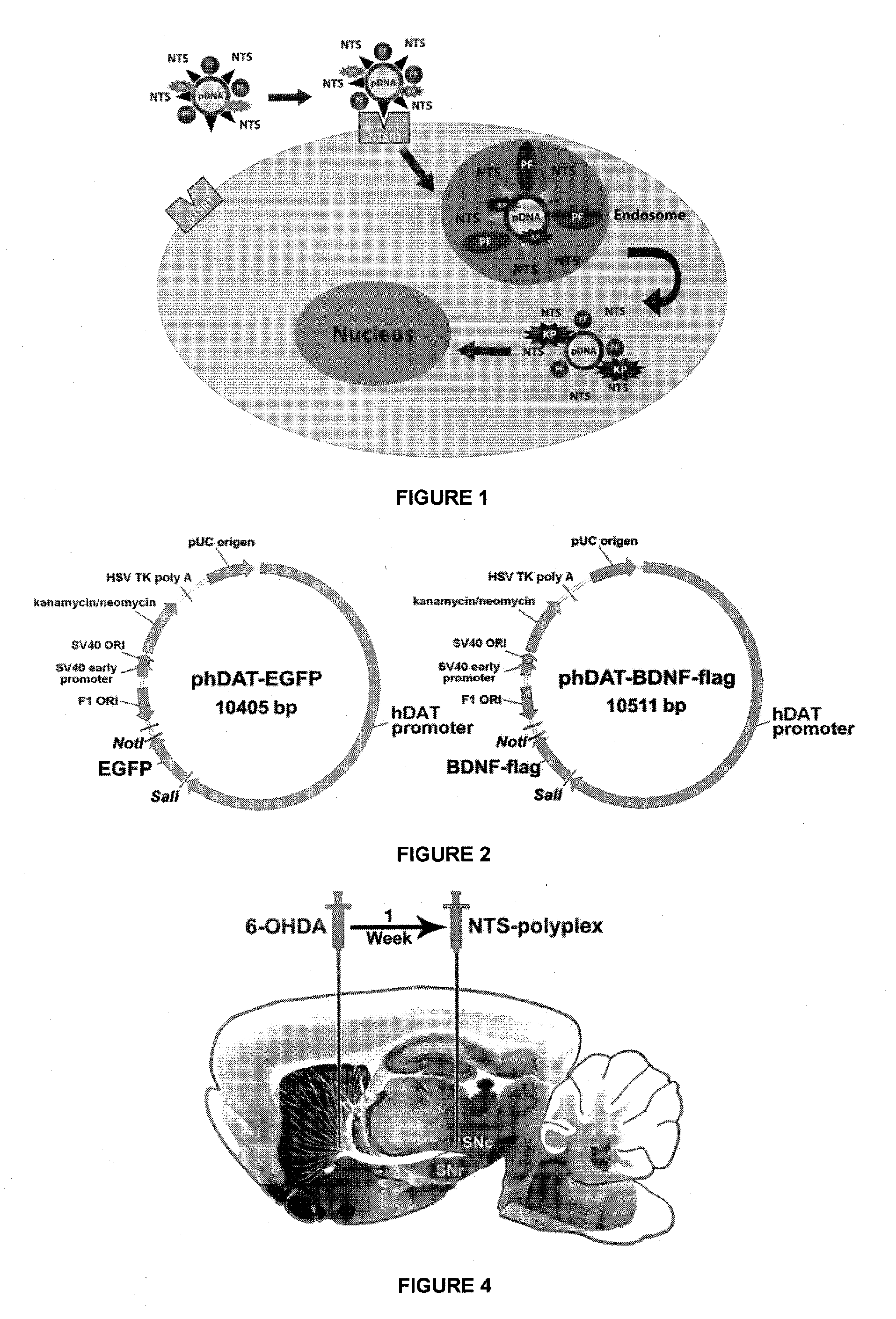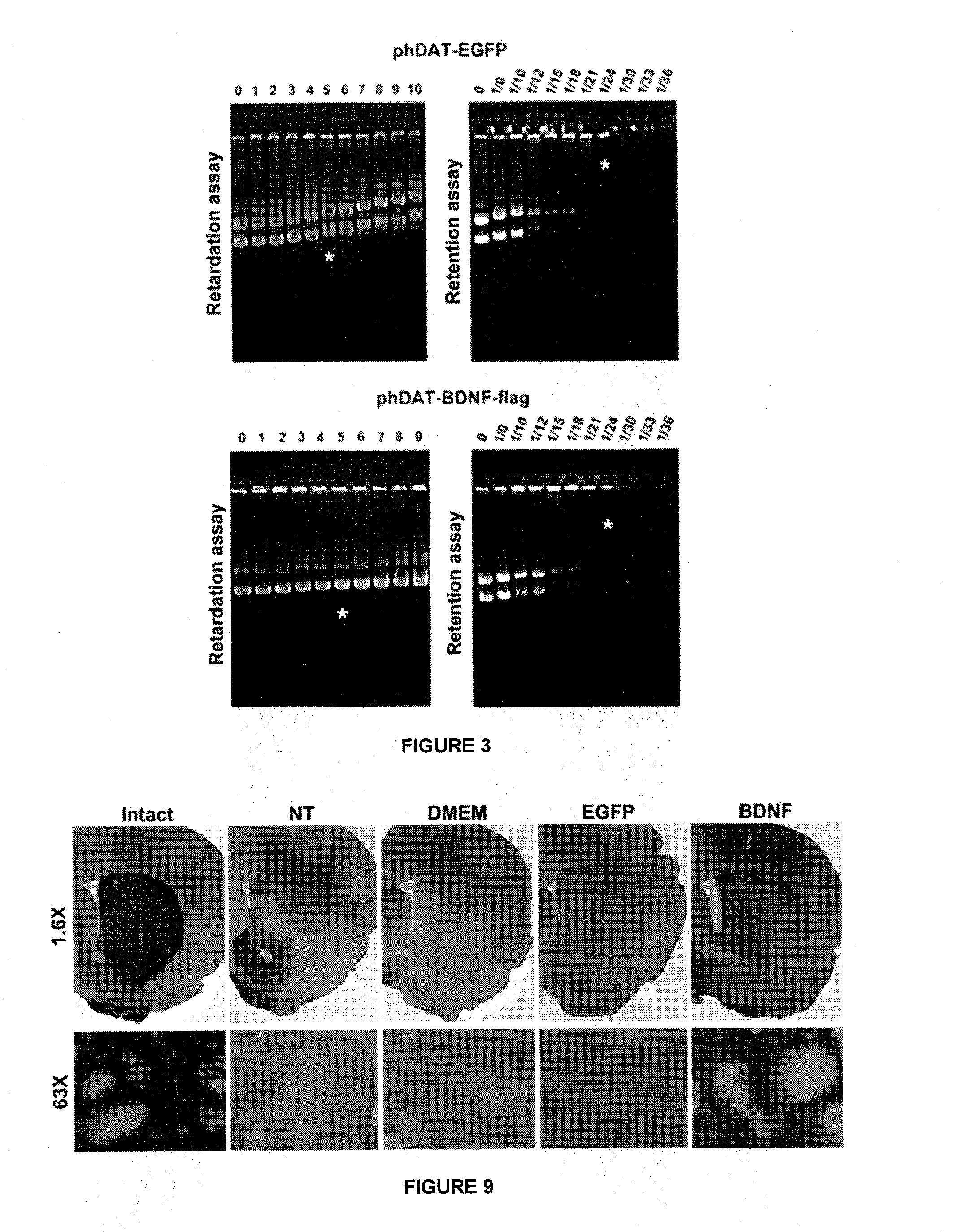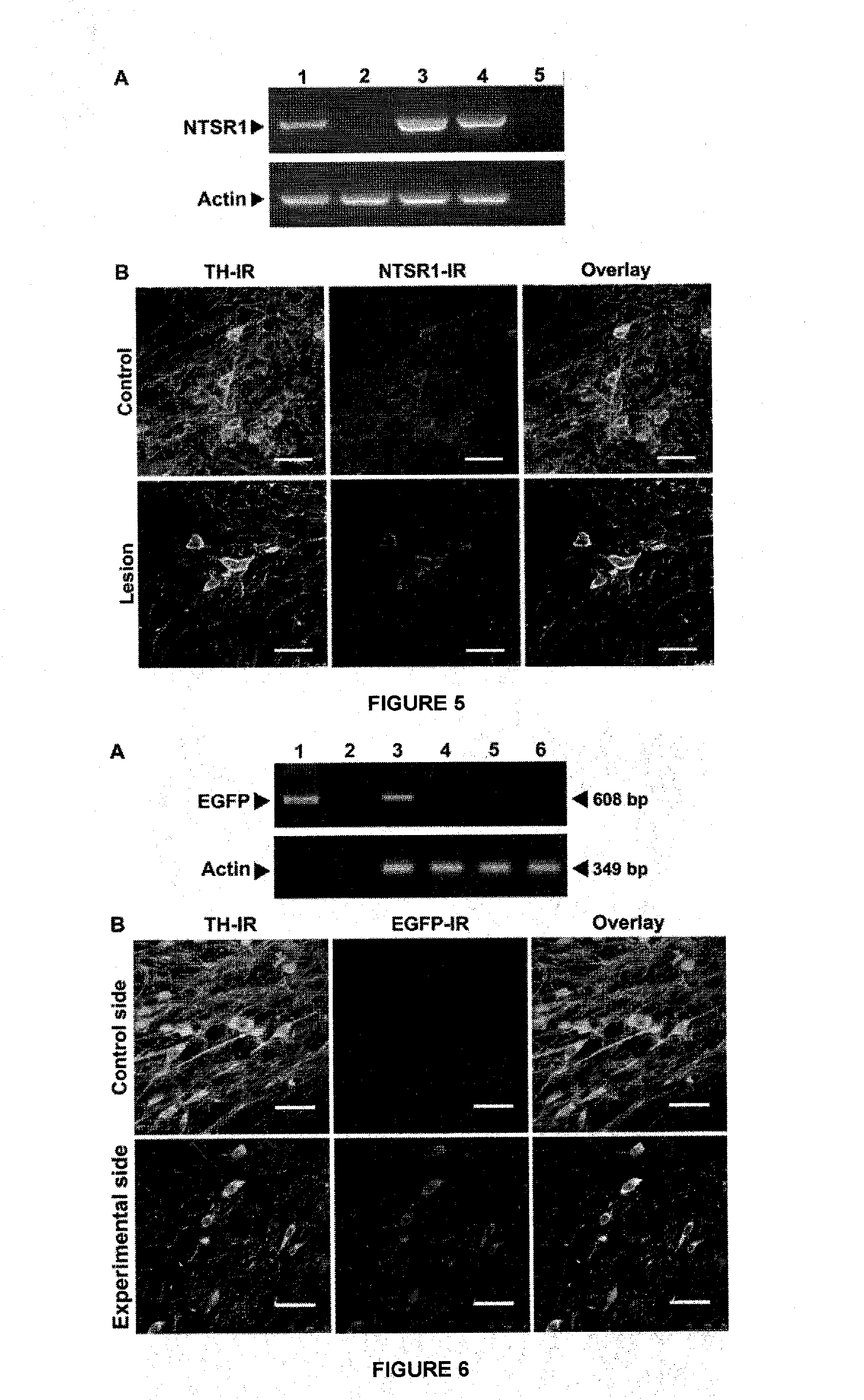Compositions and Methods for Parkinson's Disease Treatment by BDNF-flag Gene Transfer through Neurotensin Polyplex to Nigral Dopamine Neuro
a technology of nigral dopamine and flag gene, applied in the field of in vivo transgene technology, can solve the problems of insufficient restoration of the function of the damaged nigrostriatal dopaminergic system, plastic changes, and inability to achieve a functional repair of the system, so as to reduce the amphetamine-induced rotational behavior, increase the bdnf level, and restore the effect of bdn
- Summary
- Abstract
- Description
- Claims
- Application Information
AI Technical Summary
Benefits of technology
Problems solved by technology
Method used
Image
Examples
example 1
Construction of Plasmids
[0082]The plasmid phDAT-EGFP-N1 (10.45 Kbp), encoding the green fluorescent protein (GFP) under control of the promoter hDAT (human dopamine transporter), was obtained from the cloning of the 5′ end of the regulatory region of 6250 bp of hDAT in the Eco47III / BgIII sites of pCMV-EGFP1-N1 (Clontech, Palo Alto, Calif., USA) (Bannon et al., 2001; Sacchetti et al., 1999). FIG. 2 shows the simplified restriction map of phDAT-EGFP-N1.
[0083]The plasmid phDAT-BDNF-flag (10.511 Kbp), encoding the BDNF-flag gene under control of the promoter hDAT, was used as neurotrophic gene in the present invention. The plasmid phDAT-BDNF-flag was obtained from cloning BDNF-flag of 868 bp into the NotI / SalI sites of phDAT-EGFP-N1. In a first step, the removed 847 bp restriction fragment from pAD1-BDNF-flag plasmid using Hind III enzyme and NotI was subcloned into the pBluescript SK (+) plasmid, thus generating the plasmid pBluescript SK(+)-BDNF-flag. In this plasmid, we sequenced the...
example 2
Synthesis of NTS-Polyplex
[0084]We make here a brief description of the synthesis of NTS-polyplex, because the detailed procedure can be found in previous publications from our laboratory (Arango-Rodriguez et al., 2006; Martinez-Fong and Navarro-Quiroga, 2000; Navarro-Quiroga et al., 2002). In a first step, the NTS (Sigma; Saint Louis, Mo., USA) and modified PF-hemagglutinin-HA2 of influenza virus (GLFEAIAEFIEGGWEGLIEGCAKKK; >90% purity; SynPep; Dublin, Calif., USA) were conjugated with poly-L-lysine (PLL; average molecular mass 48 kD) using LC-SPDP cross-linker. The SPDP derivatives and the NTS-SPDP-(PF-SPDP)-PLL conjugate were purified by size exclusion chromatography; the latter is known as “NTS carrier.” The NTS carrier was dialyzed into a phosphate buffer solution (PBS pH 7.4) and concentrated to a final volume of 1 mL. Subsequently, this concentrate was sterilized by membrane filtration of 0.2 μm and preserved at −70° C. until use.
[0085]In a second step, we performed the assemb...
example 3
Lesion and Transfection Method
[0088]We used male rats of Wistar strain, weighing an average of 210-230 grams and subjected them to stereotactic surgery to generate the lesion with 6-OHDA or false lesion (FLN) and transfected with the NTS-polyplexes, or injected with DMEM (false transfection). Prior to stereotactic surgery, the animals were anesthetized by intraperitoneal administration of ketamine (70 mg / Kg)-xylazine (6 mg / Kg). Under deep anesthesia, the animals were placed in the stereotaxic apparatus. After cranial trepanation with a dental drill, the animals received a single injection of 3 μL of the 6-OHDA neurotoxin solution (6.7 μg free base / μL phosphate buffer 0.1 M (PBS) containing 0.2% ascorbic acid as antioxidant). 6-OHDA was prepared at the time of application and preserved at 4° C. in the dark to avoid degradation. Control animals with the false lesion (FLN) received only 3 μL of PBS with 0.2% ascorbic acid. In both cases, the neurotoxic and control solutions were admini...
PUM
| Property | Measurement | Unit |
|---|---|---|
| Fraction | aaaaa | aaaaa |
| Fraction | aaaaa | aaaaa |
| Fraction | aaaaa | aaaaa |
Abstract
Description
Claims
Application Information
 Login to View More
Login to View More - R&D
- Intellectual Property
- Life Sciences
- Materials
- Tech Scout
- Unparalleled Data Quality
- Higher Quality Content
- 60% Fewer Hallucinations
Browse by: Latest US Patents, China's latest patents, Technical Efficacy Thesaurus, Application Domain, Technology Topic, Popular Technical Reports.
© 2025 PatSnap. All rights reserved.Legal|Privacy policy|Modern Slavery Act Transparency Statement|Sitemap|About US| Contact US: help@patsnap.com



